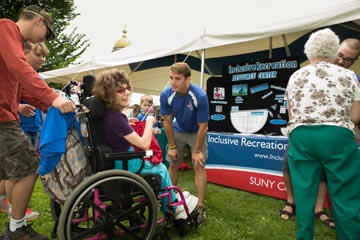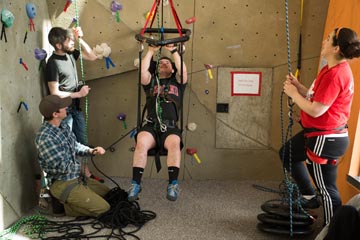Bulletin News

06/07/2016
From summer camps to community playgrounds, children and youth of all abilities across New York state soon will benefit from a $400,000 grant awarded to further the success of a visionary recreation program housed at SUNY Cortland.
The College’s Inclusive Recreation Resource Center (IRRC) — a one-stop shop for recreation professionals and people with disabilities seeking accessibility information — will use the funds awarded by the New York State Developmental Disabilities Planning Council (DDPC) to take on a two-year, two-part project.
One piece involves delivering a training program known as Inclusion U to teenagers online.
 |
|
| Community groups across the state will benefit from the IRRC's newest initiative to provide expert training. |
The other, larger portion of the grant will enable the College to provide expert training to 15 youth agencies across the state over each of the next two summers. The overall goal is to fully incorporate long-lasting best practices for inclusive play into their programs.
“The dream is that all parks and rec departments, camps and youth organizations will one day make this a staple of their training,” said Lynn Anderson, the IRRC’s founder and a SUNY distinguished service professor of recreation, parks and leisure studies at the College. “The goal is to get teenagers thinking about inclusion during their formative years and all of the things they can do to promote inclusive recreation environments.”
The grant’s work will look to reach ethnically diverse areas, especially those that traditionally are underserved when it comes to promoting health, fitness and recreation.
“When we choose the 15 agencies that we’re going to mentor each summer, we’re going to focus on the ones that meet those criteria,” Anderson said.
The IRRC, which launched in 2007, offers many different services to help recreation destinations improve accessibility and to assist people with disabilities find leisure sites that can accommodate their needs. Funded by the New York State DDPC, the center’s most robust tools are available online.
The IRRC’s recreation referral service offers an individualized recreation recommendation for people who may have difficulty gaining access to buildings or parks due to a disability. The center’s online recreation database — arguably its most impressive tool — provides detailed inclusion information about more than 1,100 sites across the nation, from parks to museums to baseball stadiums. It can be found online at search.inclusiverec.org.
The database includes basic information, such as parking availability, but goes further to include the width of restroom doors, the slope of accessible ramps and many other facility features of interest to individuals with disabilities and their families.
Inclusion U, the IRRC’s training program that teaches best practices for inclusion, has produced more than 4,000 certified inclusivity assessors. Those are people who can measure, collect and compile accurate and descriptive accessibility information about recreation sites. Many teenagers would be trained as assessors through the new funding, but Anderson said the goal has a larger goal in mind.
“What we’re more interested in is attitudinal,” she said. “We want kids to open their eyes to the activities that they can do as part of a summer staff to ensure that all children are a part of recreation activities.”
Although the bulk of the IRRC’s work assesses sites and opportunities in New York state, the center’s reach continues to grow across the country. Partners such as the University of Wisconsin–La Crosse, the University of Wisconsin–Stevens Point and San Jose State University have weaved IRRC’s training into their curriculums. Anderson and colleague Vicki Wilkins, a professor of recreation, parks and leisure studies, also have led Inclusion U sessions internationally, most recently in Calgary.
The new grant focuses exclusively on youth organizations in New York state.
“The dream would be for Eagle Scouts to take this a step further and use it as a common pathway for their final projects,” Anderson said. “And hopefully, that work would benefit people who need it the most.”

